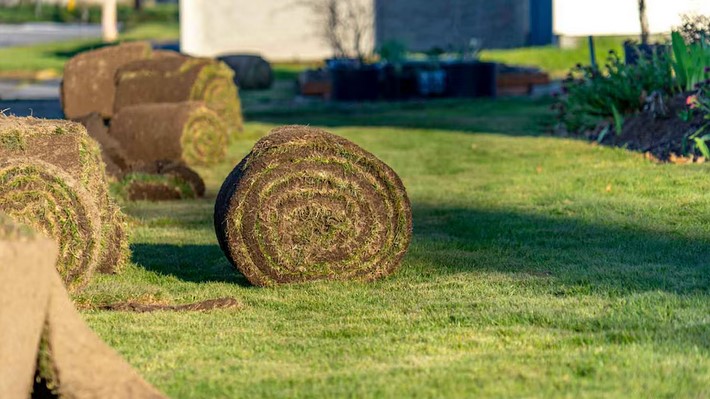Sod Stories: Exploring Different Types of Sod for Lawns

Sod Stories is a comprehensive guide to exploring different types of sod for lawns. Whether you are a homeowner looking to spruce up your yard or a professional landscaper looking for the best sod for a client, this guide will provide you with the information you need to make an informed decision. We will discuss the different types of sod available, the benefits and drawbacks of each type, and the best practices for installation and maintenance. With this guide, you will be able to make the best decision for your lawn and ensure that it looks its best for years to come.
Exploring the Benefits of Different Types of Sod for Lawns
The use of sod for lawns has become increasingly popular in recent years due to its ability to quickly establish a lush, green lawn. Sod is a layer of grass and soil that is cut from a larger piece of land and transplanted to a new location. Sod is an ideal choice for homeowners who want to quickly establish a lawn without having to wait for grass seed to germinate. There are several types of sod available, each with its own unique benefits.
Bermuda grass is a popular choice for warm climates due to its ability to withstand heat and drought. It is a low-maintenance grass that requires minimal mowing and fertilizing. It is also resistant to pests and diseases, making it a great choice for those who want a low-maintenance lawn.
St. Augustine grass is a popular choice for warm climates due to its ability to tolerate shade and salt. It is a low-maintenance grass that requires minimal mowing and fertilizing. It is also resistant to pests and diseases, making it a great choice for those who want a low-maintenance lawn.
Fescue grass is a popular choice for cooler climates due to its ability to tolerate cold temperatures. It is a low-maintenance grass that requires minimal mowing and fertilizing. It is also resistant to pests and diseases, making it a great choice for those who want a low-maintenance lawn.
Zoysia grass is a popular choice for warm climates due to its ability to tolerate heat and drought. It is a low-maintenance grass that requires minimal mowing and fertilizing. It is also resistant to pests and diseases, making it a great choice for those who want a low-maintenance lawn.
Centipede grass is a popular choice for warm climates due to its ability to tolerate heat and drought. It is a low-maintenance grass that requires minimal mowing and fertilizing. It is also resistant to pests and diseases, making it a great choice for those who want a low-maintenance lawn.
Overall, there are many types of sod available for lawns, each with its own unique benefits. Homeowners should consider their climate and the amount of maintenance they are willing to do when selecting the type of sod that is best for their lawn. With the right type of sod, homeowners can quickly establish a lush, green lawn that is both attractive and low-maintenance.
Comparing the Different Types of Sod for Different Lawns and Landscapes
When it comes to selecting the right type of sod for a lawn or landscape, there are a variety of factors to consider. Different types of sod have different characteristics that make them suitable for different types of lawns and landscapes. This article will discuss the different types of sod and their advantages and disadvantages for different lawns and landscapes.
The most common type of sod is Kentucky bluegrass. This type of sod is known for its deep green color and its ability to withstand heavy foot traffic. It is also relatively drought-tolerant and can be used in a variety of climates. However, it is not as shade-tolerant as some other types of sod, so it may not be the best choice for shady areas.
Bermuda grass is another popular type of sod. It is known for its ability to withstand heat and drought, making it a great choice for hot climates. It is also very durable and can handle heavy foot traffic. However, it is not as cold-tolerant as some other types of sod, so it may not be the best choice for colder climates.
St. Augustine grass is a popular choice for warm climates. It is known for its thick, lush texture and its ability to withstand heavy foot traffic. It is also relatively shade-tolerant, making it a great choice for shady areas. However, it is not as drought-tolerant as some other types of sod, so it may not be the best choice for dry climates.
Fescue grass is a popular choice for cooler climates. It is known for its deep green color and its ability to withstand cold temperatures. It is also relatively shade-tolerant, making it a great choice for shady areas. However, it is not as drought-tolerant as some other types of sod, so it may not be the best choice for dry climates.
When selecting the right type of sod for a lawn or landscape, it is important to consider the climate, the amount of foot traffic, and the amount of shade in the area. Different types of sod have different characteristics that make them suitable for different types of lawns and landscapes. By taking the time to research the different types of sod and their advantages and disadvantages, homeowners can make an informed decision about which type of sod is best for their lawn or landscape.Sod Stories has provided a comprehensive overview of the different types of sod available for lawns. From the various grasses and mixes to the different installation methods, this guide has given readers a better understanding of the different options available. With this knowledge, homeowners can make an informed decision when selecting the best type of sod for their lawn.